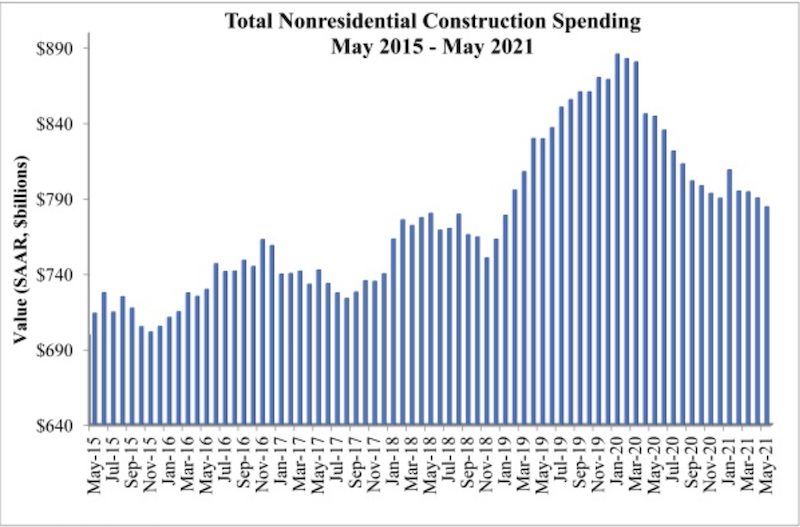In its first-quarter index of Construction Confidence, the Associated Builders and Contractors (ABC) found that 55% of contractors expected their sales to increase over the following six months, and only 19% thought their sales would decline in that period.
They might need to recalibrate their exuberance, in light of the trade group’s latest analysis of data published by the U.S. Census Bureau, which ABC released today. It estimates that national nonresidential construction spending in May, at $784.5 billion, was down 7.1% from the same month a year ago, and off 0.7% from spending levels in April 2021.
On a year-over-year basis, spending for every nonresidential category that ABC tracks, except sewage and waste disposal, was negative. Spending on public safety projects—which surged during the early months of the pandemic—showed the greatest decline in May, 39.6%, and lodging also took a big hit (off 23.3% to $22.6 billion). On the other hand, spending in May on healthcare construction, nearly $47 billion, was down only marginally, by 1.5%, compared to the same month a year ago.
WORKER SHORTAGES AND MATERIAL PRICING REMAIN PROJECT ROADBLOCKS

Construction spending for public safety and lodging projects showed the steepest declines in May compared to the same month a year ago.
A red-hot data center market hasn’t spelled more office construction, notes Anirban Basu, ABC’s Chief Economist. Basu also points out that while some private construction segments are struggling under the dislocating impacts of the pandemic, public nonresidential construction actually has declined more rapidly than the private sector over the past year.
Basu sees some hope for the future. Public construction spending should benefit from improvements in state and local governments’ financial conditions. But he tempers his predictions because of still-high construction materials prices and “deeply problematic” worker shortages. Basu expressed some concern, too, about the disproportionate amount of spending moving toward residential construction, which accounted for 41% of the pre-pandemic total and 49% in May.
Related Stories
University Buildings | Jul 17, 2024
University of Louisville Student Success Building will be new heart of engineering program
A new Student Success Building will serve as the heart of the newly designed University of Louisville’s J.B. Speed School of Engineering. The 115,000-sf structure will greatly increase lab space and consolidate student services to one location.
Healthcare Facilities | Jul 16, 2024
Watch on-demand: Key Trends in the Healthcare Facilities Market for 2024-2025
Join the Building Design+Construction editorial team for this on-demand webinar on key trends, innovations, and opportunities in the $65 billion U.S. healthcare buildings market. A panel of healthcare design and construction experts present their latest projects, trends, innovations, opportunities, and data/research on key healthcare facilities sub-sectors. A 2024-2025 U.S. healthcare facilities market outlook is also presented.
K-12 Schools | Jul 15, 2024
A Cleveland suburb opens a $31.7 million new middle school and renovated high school
Accommodating 1,283 students in grades 6-12, the Warrensville, Ohio school complex features flexible learning environments and offers programs ranging from culinary arts and firefighting training to e-sports.
MFPRO+ News | Jul 15, 2024
More permits for ADUs than single-family homes issued in San Diego
Popularity of granny flats growing in California
Codes and Standards | Jul 15, 2024
New York City code update changes definition of a major building
Changes affecting how construction projects in New York City are permitted will have significant impacts for contractors. On Dec. 11, the definition of a major building in the city’s code will change from 10 stories to seven, or 75 feet. The change will affect thousands more projects.
Adaptive Reuse | Jul 12, 2024
Detroit’s Michigan Central Station, centerpiece of innovation hub, opens
The recently opened Michigan Central Station in Detroit is the centerpiece of a 30-acre technology and cultural hub that will include development of urban transportation solutions. The six-year adaptive reuse project of the 640,000 sf historic station, created by the same architect as New York’s Grand Central Station, is the latest sign of a reinvigorating Detroit.
Healthcare Facilities | Jul 11, 2024
New download: BD+C's 2024 Healthcare Annual Report
Welcome to Building Design+Construction’s 2024 Healthcare Annual Report. This free 66-page special report is our first-ever “state of the state” update on the $65 billion healthcare construction sector.
Transit Facilities | Jul 10, 2024
Historic Fresno train depot to be renovated for California high speed rail station project
A long-shuttered rail station in Fresno, Calif., will be renovated to serve as the city’s high speed rail (HSR) station as part of the California High-Speed Rail Authority system, the nation’s first high speed rail project. California’s HSR system will eventually link more than 800 miles of rail, served by up to 24 stations.
Contractors | Jul 9, 2024
The average U.S. contractor has 8.4 months worth of construction work in the pipeline, as of June 2024
Associated Builders and Contractors reported today that its Construction Backlog Indicator increased to 8.4 months in June, according to an ABC member survey conducted June 20 to July 3. The reading is down 0.5 months from June 2023.
Government Buildings | Jul 8, 2024
GSA adopts new accessibility guidelines for federal properties
The U.S. General Services Administration (GSA) adopted a new rule with new accessibility guidelines for federal buildings. The rule establishes that pedestrian facilities in the public right-of-way are readily accessible to and usable by people with disabilities.

















